![]()
EF-70 User Manual
Multi-Modal Biometrics Terminal: Unified Iris and Facial Recognition in a Single Capture
Version 0.6.0, September 2024
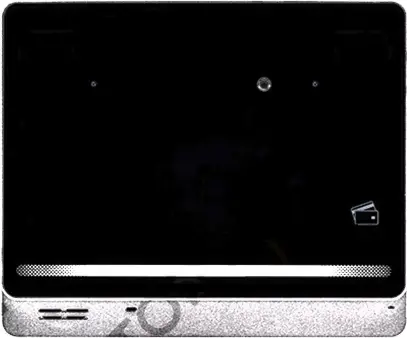
APPLICATION
Highly versatile enrollment and authentication station with flexible mounting options for physical access control and other ID management applications
About This Manual
EF-70 is an integrated biometric terminal that simultaneously captures facial and iris data using an innovative user positioning system. This manual contains the descriptions and operational instructions for EF-70 device. It is intended and written for system administrators who are in charge of overall operation including installation and management. We recommend you familiarize yourself with this manual in order to make use of the product correctly and effectively.
![]()
- The figures and screenshots in this guide are given for illustration purposes only and may differ from the actual product.
- Due to continuous technological improvements, the guide may not contain the most updated information. For further information not covered in this guide, please contact us at service@cmi-tech.com or sales@cmi-tech.com.
Conventions in This Manual
The following symbols are used throughout this manual. Make sure that you fully understand the meaning of each symbol and follow the instructions accompanied.
| Symbol | Name | Description |
 | WARNING | Indicates information that should be followed with the utmost care. Failure to comply with a warning could cause severe damage to the equipment or injury to personnel. |
 | CAUTION | Indicates a potentially hazardous situation which, if not avoided, could result in equipment damage, data loss, performance degradation, or unexpected results. |
 | IMPORTANT | Emphasizes essential information required for user success. |
 | NOTE | Provides important supplemental information that might enhance users’ understanding or alternative steps to accomplish their goals. |
| TIP | Provides optional information to help users be more successful in their tasks. |
Safety Instructions
Follow the safety instructions to use the product safely and prevent any risk of personal injury or damage to the product.
![]() WARNING
WARNING
Choosing Location
- DO NOT expose the product to direct sunlight, excess heat, open flames, corrosive gasses, moisture, or dust. Doing so may cause electrical shock, electrical short, or fire.
- DO NOT install the product near heaters, air conditioners, electrical fans, refrigerators, or water. Doing so may create the risk of a short circuit or fire caused by water or condensation that may come into contact with the product.
- DO NOT install the product in an environment that is susceptible to explosion.
Operation
- DO NOT let any type of liquid, mists, or sprays get into the product. Doing so may cause electrical shock, electrical short, or product damage.
- If smoke, odors or noise rise from the device, stop using the device immediately, disconnect the power cable, and contact our customer support.
Maintenance
- DO NOT attempt to dissemble, repair, or modify the device yourself. Opening or removing covers may expose you to electrical shock or other risks and may void your warranty. If the product does not work correctly, contact your dealer or our customer support.
![]() CAUTION
CAUTION
Choosing Location
- Keep the front side of the device away from strong ambient light, direct sunlight, or both. Sunlight, halogen lamps or other strong illumination may degrade the performance of the device, that is, increase in failure-to-capture rates or occasional authentication problem.
- DO NOT install the product outdoors unless environmental factors such as water, temperature, or sunlight in the location are controlled by means of proper protection.
- DO NOT expose the product to high electro-magnetic radiation. Device failure or performance degradation may occur caused by electro-magnetic interference.
- DO NOT install the product next to devices that contain magnets or generate magnetic fields such as speakers. Device malfunction or performance degradation may occur caused by magnetic interference.
Installation
- DO NOT install the product on a surface subject to vibration or physical shock. Doing so can cause damage to the product.
- When you install the product on a wall, make sure that you secure the product with the provided fasteners. Dropping from the wall may cause damage to device casing, internal parts, or both.
- DO NOT install the power supply cable in a high-traffic area where people pass by. Doing so may create a trip hazard and cause the cable to become worn or frayed.
- Use only a power cord set complying with the national regulation of the countries intended for sale.
- Use only the power adapter which is either provided or approved by CMITECH for the product to operate properly and safely.
- DO NOT connect multiple devices to one power adapter. Overload on power adapter may cause over-heat or fire hazard.
- DO NOT use any type of extension cord to connect the product to a power supply.
Operation
- DO NOT use any sharp tools when pressing the buttons to prevent damage to the touch screen from scratches or cuts.
Maintenance
- When cleaning the product, wipe the product with a soft and dry cloth. Do not apply water, benzene, alcohol, or spray cleaner. These may cause product failure or fire.
1. Introduction to EF-70
The EF-70 combined face and iris recognition system provides unprecedented subject ease of use for both through a highly innovative and intuitive user positioning approach in both modalities.
Subjects will view their own face in a front-facing, high resolution 5.0-inch color display to position themselves correctly within the real-time graphic interface.
For iris recognition, which has a working distance range of 40 to 70 cm, they will intuitively and naturally move to the correct position by simply centering and sizing their face image to the box within the display. In addition, the positioning box and the top border turn green to indicate proper distance positioning, after which the iris biometrics images are automatically collected, provided that the real time image quality metrics are satisfied. Vocalized commands give additional positioning guidance in real time. For face recognition, the working distance is 0.4 to 1.0 meters so that the subject needs only look at the display to initiate face image capture.
The EF-70 can be configured in automatic recognition mode in several dual factor and multifactor combinations with the on-board card reader and PIN capabilities. In addition, the system meets industry standards for iris and face image capture making it ideal for large scale enrollment programs. In particular, the EF-70 exceeds the ISO 19794-6 iris image spatial resolution specification, delivering an impressive 3.0 lp /mm at 50% contrast.
The system is extremely fast in both subject detection and image capture. It utilizes an integrated time-of-flight (TOF) proximity and distance sensor for fast and precise detection of all subjects as they approach the system. Typical image capture times in recognition mode will be 0.5 seconds or less.
For all specifications, please see Specifications section.
1.1. Key Features
| Feature | User Advantages |
| State-of-the-art optical design | The optical design includes utilizing highest quality optics and very fast shutter speeds, which allows the systems to exceed industry standards for image quality. |
| Multiple camera design | Four cameras for ultra-fast subject positioning and flexibility in either face or iris recognitions mode |
| Advanced, proprietary stereoscopic eye localization in iris modality | The EF-70 accurately locates the position of both eyes in 3D to optimize system speed, subject ease of positioning and iris image quality. This function enables reliable subject distance positioning indicators shown as blue, green or red color distance positioning codes. |
| Highest image quality | Meets or exceeds the ISO 19794-6 2011 and ISO 29794-6 iris imaging specifications. |
| Compact, lightweight design | Optimizes placement or mounting options, including wall, swing arm, or e-Gate mounting solutions. |
| Simplest of iris recognition user instructions | Very simple and repeatable subject instructions:
Iris image capture is automatic once subject is in proper position and real time image quality metrics parameters are met. |
| Intuitive face recognition user interface | Modeled after latest smart-phone user displays, the user experience will be intuitive and effortless for almost all subjects. |
| Iris recognition stand-off distance and depth of capture | 40 to 70 cm, ensuring robust, fast and easy positioning. Comfortable range for subjects in wide variety of desktop, countertop, kiosk or wall mount placements. |
| Face capture range | From 0.4 to 1.0 meters |
| Real time image quality metrics | Image quality metrics included in capture algorithm:
|
| Simultaneous face image capture in iris recognition mode | A face image is always collected at same time as capture of iris images, so that the minimum data record consists of one face image and two iris images. |
| Large, embedded data bases for on-board identification and authentication | Standard on-board (local) iris database of 200,000 subjects (iris template-pairs), with matching speed of under 1.0 second in 1:N mode for full database. Face template data base size of 50,000 subjects |
| Versatile dual and multi-factor configuration support | Various authentication configurations with biometrics modalities and PIN or card |
| Standard embedded MIFARE card reader | Supports MIFARE, DESFire, MIFARE Plus, and MIFARE Classic cards (ISO/IEC 14443) including latest EV3 version |
| Optional HID card reader | Optional hardware version replaces MIFARE reader with HID OmniKey chipset reader for HID iClass and iClass SE cards |
| OSDP | Supported through RS-485 terminals |
| Template-on-card (TOC) | Supported for both MIFARE and HID card readers |
| Cable connectors | For access control (AC) version, plug-in connector kit for all cabling (except RJ-45 Ethernet) included in accessories package |
| Card reader | Standard in AC version only: embedded MiFare / DesFire card reader for support of dual factor authentication, or backup authentication for special case users. |
| I/O interface | Standard connections include TCP/IP(Ethernet), Wiegand IN, Wiegand OUT, 4 x GPI, 2 x RS-485, RS-232, contact relay, tamper, factory reset, SIM socket (factory option) |
| Language support | Display languages of English, Korea, Traditional Chinese, Simplified Chinese, Japanese, Spanish, Italian, Arabic, and Russian. |
| Voice positioning commands | Vocalizations for positioning guidance can be modified by local systems integrators through modification of on-board .wav files, or by special request to CMITech support. |
1.2. Parts and Controls
1.2.1. Front
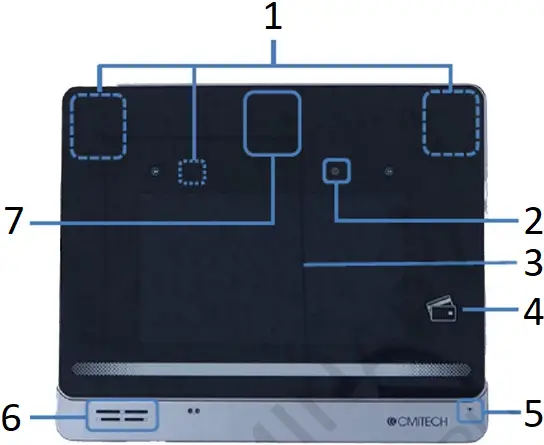
- NIR illuminators
- Face Camera
- LCD display
- Smart card reader
- MIC
- Speaker
- Iris Camera
| Name | Description | Note |
| Iris Camera | Captures the iris images | |
| Face Camera | Captures the face images | |
| NIR Illuminators | Illuminates the face using the NIR lighting when capturing the faces | |
| LCD display | Shows preview images before capture and provides a graphical interface for enrollment and device configuration | |
| Smart card reader | Indicates the area where RF cards can be read | |
| Speaker | Delivers sound from device | |
| Mic | Captures sound from the user |
1.2.2. Bottom

- Lock Screw
- Reset
- USB-C OTG (for connection to PC host or USB Memory)
| Name | Description | Note |
| Lock Screw | Attaches the mounting plate to the unit | |
| USB-C OTG port | Connects a USB flash drive or a PC host | |
| Reset button | Restarts device |
1.2.3. Rear
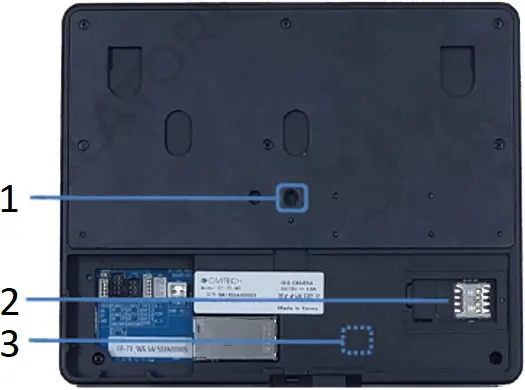
- Tripod Socket (¼-20)
- SIM Card Slot
- Tamper Switch
| Name | Description | Note |
| Tripod socket | Attaches the unit with a tripod that has the standard ¼-20 UNC screw | |
| SIM card slot | A SIM card can be inserted | Optional |
| Tamper Switch | Starts an alarm, if configured, when a physical tampering attempt is detected | Switch type: Magnetic |
1.2.4. Connector
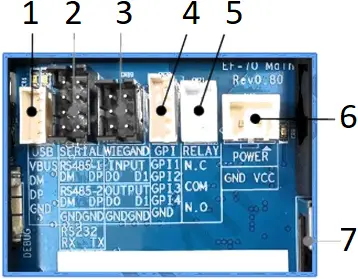
- USB
- RS-232 / RS-485
- Wiegand IN / OUT
- GPI
- Relay
- DC Power Input (+12 to 24V)
- LAN/RJ45
| Name | Description | Note |
| USB | Connects a USB cable | |
| RS-232 / RS-485 | Connects a RS-485 or RS-232 cable | |
| Wiegand IN / OUT | Connects the Wiegand cable as input or output | |
| GPI | Connects a GPI cable | |
| Relay | Connect a relay cable | |
| Power Input | Connects the power cable | |
| LAN/RJ45 | Connects an ethernet cable |
2. Using EF-70
2.1. Overview
The on-board demonstration application shows the full capabilities of the EF-70 for image capture including subject positioning with the face display user interface, enrollment, and onboard matching (authentication).
The system boots up in this demo application. It is initiated by the video based motion detector that first finds the subject from about 1 meter distance, and then continues the natural iris and face image capture sequence for capture in recognition or authentication mode.
2.2. Enrollment
This section gives the procedural information to enroll users to the device.
1. To switch to enrollment mode, press the area on the lower-left of main screen.

![]() If the system is in image capture mode, press Home icon (
If the system is in image capture mode, press Home icon (![]() ) on top left of active user interface display, which will stop Recognition mode and return system to Launcher page.
) on top left of active user interface display, which will stop Recognition mode and return system to Launcher page.
2. The main User screen appears.
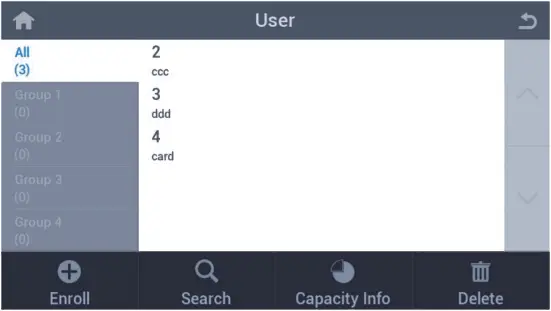
![]() This user screen also allows simple database management. By tapping the Delete icon in the bottom right, one can easily delete information of enrolled users.
This user screen also allows simple database management. By tapping the Delete icon in the bottom right, one can easily delete information of enrolled users.
3. To enroll a new user, press the Enroll icon to bring up Enroll User screen.

4. Press the plus (+) button in the bottom left to capture image of the new user.
5. An instruction screen will appear for 3 to 5 seconds, and then switch to the user interface. (The timing of this display can be changed in Settings.)
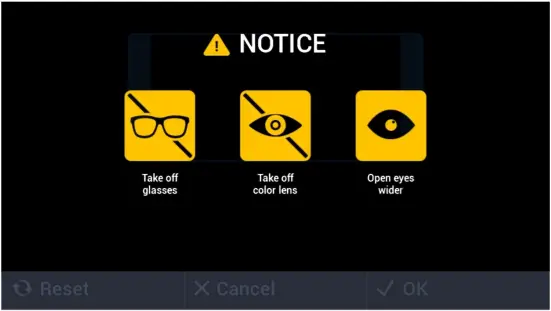
6. After successfully capturing iris images, click ![]() OK to accept images. The system then returns to Enroll User screen.
OK to accept images. The system then returns to Enroll User screen.
7. Click on the Name field to enter name of subject, then click on ![]() OK to complete enrollment.
OK to complete enrollment.
8. Press the Home icon (![]() ) to return to the Launcher page to re-start Recognition and Authentication mode.
) to return to the Launcher page to re-start Recognition and Authentication mode.
2.3. Authentication
EF-70 detects a subject and captures the images of subject’s irises and face automatically once it’s at an appropriate distance and position.
1. Position yourself facing straight at the LCD display. When the device detects your movement within 1.0meter range, it initiates the image capture sequence. A rectangular-shaped user guide box will appear on the screen. If it is BLUE, it means you are too far from the device. Move forward.
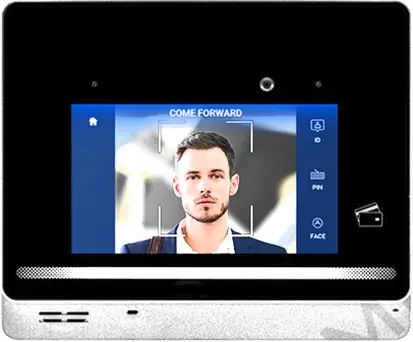
2. Move towards the system to size your face to the LCD display. If the user guide box flashes GREEN, it means you are at an appropriate position. Stop and hold your position until the device captures image of your face and/or iris.
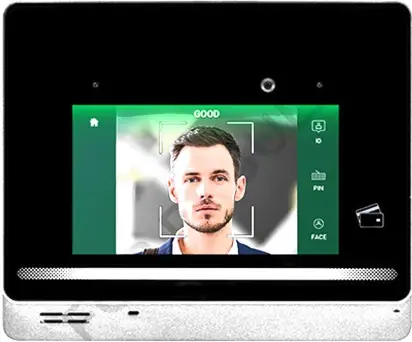
3. If you are standing too close to the device, your face will not fit in the LCD display. When the user guide box flashes RED, it means the device cannot capture your image because you are too close. Move back until the box turns green.

3. Product Specifications
3.1. Mechanical Specifications
Dimension (unit: mm)
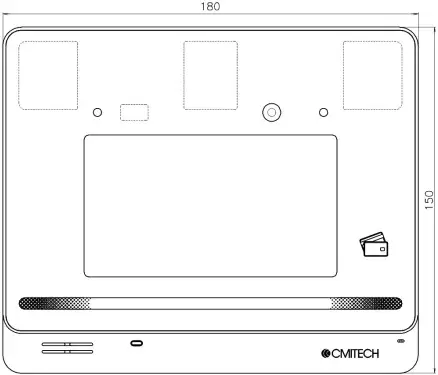


3.2. Technical Specifications
| Specification | Description |
| Embedded CPU | ARM quad-core |
| On-board iris and face algorithms for embedded encoding and matching | Standard in all configurations |
| Supported biometrics modes | Iris only, face only, iris first then face, iris or face, iris and face |
| Flexible Software Development Kit (SDK) configurations | High Level SDKs offered in C# (.NET), C++, C, and Java versions. Includes host side reference application to connect to EF-70 resident services layer so that integrator does not need to program EF-70 device. |
| Configuration Utility software application | This host side software application provides centralized (network) control and setup of system configuration, Wiegand settings, and IP address settings, as well as providing for centralized FW upgrades. |
| Dimensions | 180 x 150 x 32 mm (7.1 x 5.9 x 1.3 inches) without mounting wall plate |
| Weight | 900 g without wall plate |
| On-board data storage | Up to 200,000 iris template pairs with match speed about 1.0 second either in 1:N mode (identification) or 1:1 mode (verification). Up to 50,000 face templates |
| Dual factor authentication | Iris or face with either smart card or PIN as second factor |
| Iris image pixel resolution | Exceeds ISO 19794-6 2011 and ISO 29794-6 iris imaging standards with MTF of 3.0 lp / mm at 50% contrast |
| Iris image output | 640 x 480 pixels, 8bit depth, supports multiple formats |
| Adjustable FAR (false accept rate) | Adjustable iris algorithm threshold range of 10-5 to 10-14 FMR at 10-6 FNMR. Default is FMR of 10-8. |
| Enrollment mode operational iris imaging distance (stand-off range) and depth of field | 50 to 70 cm range (20 cm depth of capture range) in enrollment mode. Meets or exceeds ISO 19794-6 2011 and 29794-6 specifications. |
| Recognition mode operational iris imaging distance | Recognition mode provides up to 40 to 70 cm range (30 cm depth of capture) for small scale applications. Does not necessarily meet ISO specifications. Range selectable in SDK. |
| Iris positioning indicators | Face positioning within box in LCD serves to center users face in X-Y dimensions. Subject will fit size of face to box size within LCD display for distance(Z) positioning, with simultaneous color bar display for correct distance positioning:
Supplemental voice distance feedback is also simultaneous. Vocalizations convertible to local language via .wav file substitution. |
| Auto tilt for iris imaging | Internal auto tilt range of +25 to -25 degrees, which corresponds to height range of approximately 50 cm. System can be mounted at any height to accommodate local user population. Contact CMITech for mounting recommendations. |
| Time of iris image capture and authentication | Typically about 0.5 second from time the subject’s eyes are properly placed within capture volume. |
| IR illumination for iris imaging | Dual wavelength LEDs (spectral range of 700 to 900 nm) that conforms to ISO best practices for iris imaging. |
| Face image capture | Standard 24bit color and NIR images, both accessible from SDK |
| Face recognition | Standard on-board encoding and matching |
| Audio | 1W embedded speaker |
| Operating temperature range | -20 to 50˚C |
| Humidity range | 10 to 90% RH, non-condensing |
| Illuminator eye safety standard | IEC 62471 |
| Network interface, standard | 10/100/1000 Base-T Ethernet (RJ45 connector), USB OTG support |
| RFID Card reader | Integrated CMITech MiFare and DESFire reader as standard HID Omnikey embedded chipset option for iClass cards |
| SIM card socket | Factory option |
| Mounting | ¼ – 20 UNC (consumer camera tripod mount type) standard |
| Accessories | Detachable wall mount plate for easy wall installation. Terminal and wired connectors for: Wiegand IN, Wiegand OUT, RS-232, 2 x RS-485, 4 x GPI, dry contact relay |
| OSDP | Yes, supported through RS-485 port |
| Power requirement | DC 15 V AC power adapter included in all versions. |
| Power consumption | 25 W |
| POE+ | Supported (optional) |
Appendix A: Legal Information
A.1. Disclaimer
The words of which the initial letter is capitalized have meanings defined under the following conditions. The following definitions shall have the same meaning regardless of whether they appear in singular or in plural.
For the purposes of this Disclaimer:
- Company (referred to as either “the Company”, “We”, “Us” or “Our” in this Disclaimer) refers to CMITech Co. Ltd.
- You means the individual accessing the Product, or the company, or other legal entity on behalf of which such individual is accessing or using the Product, as applicable.
- Product means the electronic device provided by the Company named EF-70 and its manual.
The information contained on the Product is for general information purposes only. The Company assumes no responsibility for errors or omissions in the contents of the Product. In no event shall the Company be liable for any special, direct, indirect, consequential, or incidental damages or any damages whatsoever, whether in an action of contract, negligence or other tort, arising out of or in connection with the use of the Product or the contents of the Product. The Company reserves the right to make additions, deletions, or modifications to the contents on the Product at any time without prior notice.
The Product may contain links to external websites that are not provided or maintained by or in any way affiliated with the Company. Please note that the Company does not guarantee the accuracy, relevance, timeliness, or completeness of any information on these external websites.
The information given by the Product is for general guidance on matters of interest only. Even if the Company takes every precaution to insure that the content of the Product is both current and accurate, errors can occur. Plus, given the changing nature of laws, rules and regulations, there may be delays, omissions or inaccuracies in the information contained on the Product. The Company is not responsible for any errors or omissions, or for the results obtained from the use of this information.
All information in the Product is provided “as is”, with no guarantee of completeness, accuracy, timeliness or of the results obtained from the use of this information, and without warranty of any kind, express or implied, including, but not limited to warranties of performance, merchantability and fitness for a particular purpose. The Company will not be liable to You or anyone else for any decision made or action taken in reliance on the information given by the Product or for any consequential, special or similar damages, even if advised of the possibility of such damages.
A.2. Copyright Notice
All rights reserved.
This documentation is copyrighted by CMITech Co., Ltd. No part of this guide may be reproduced, transmitted, or transcribed without the expressed written permission from CMITech Co., Ltd. All other product names, trademarks, or registered trademarks are property of their respective owners.
We reserve the right to make any alterations which may be required due to technical improvement. For the most current information, contact your CMITech representative.
Appendix B: Regulatory Information
B.1. FCC compliance statement
This device complies with part 15 of the FCC Rules. Operation is subject to the following two conditions: (1) This device may not cause harmful interference, and (2) this device must accept any interference received, including interference that may cause undesired operation.
![]() This equipment has been tested and found to comply with the limits for a Class B digital device, pursuant to part 15 of the FCC Rules. These limits are designed to provide reasonable protection against harmful interference in a residential installation.
This equipment has been tested and found to comply with the limits for a Class B digital device, pursuant to part 15 of the FCC Rules. These limits are designed to provide reasonable protection against harmful interference in a residential installation.
This equipment generates, uses, and can radiate radio frequency energy and, if not installed and used in accordance with the instructions, may cause harmful interference to radio communications. However, there is no guarantee that interference will not occur in a particular installation.
If this equipment does cause harmful interference to radio or television reception, which can be determined by turning the equipment off and on, the user is encouraged to try to correct the interference by one or more of the following measures:
- Reorient or relocate the receiving antenna.
- Increase the separation between the equipment and receiver.
- Connect the equipment to an outlet on a circuit different from that to which the receiver is connected.
- Consult the dealer or an experienced radio/TV technician for help.
Changes or modifications to this product not authorized by CMITech could void the electromagnetic compatibility (EMC) and wireless compliance and negate your authority to operate the product.
This product has demonstrated EMC compliance under conditions that included the use of compliant peripheral devices and shielded cables between system components. It is important that you use compliant peripheral devices and shielded cables between system components to reduce the possibility of causing interference to radios, television sets, and other electronic devices.
The antenna(s) used for this transmitter must not be co-located or operating in conjunction with any other antenna or transmitter, except in accordance with FCC multi-transmitter product procedures.
A minimum separation distance of 20cm must be maintained between the antenna and the person for this appliance to satisfy the RF exposure requirements.
B.2. EU Declaration of Conformity (CE)
This product is CE marked according to the provisions of the RED (Radio Equipment Directive) Directive (2014/53/EU). CMITech Co., Ltd. hereby declares that this product is in compliance with the essential requirements and other relevant provisions of Directive 2014/53/EU. This device is a class 1 radio device according to the directive. For more information, contact us using the following contact information.
CMITech Company, Ltd.
- Website: https://www.cmi-tech.com/
- Address: 4F, #417 – 419, 136, LS-ro, Dongan-gu, Anyang-si, Gyeonggi-do, 14118, Republic of Korea
- Tel: +82-70-8633-8278 / Fax: +82-31-624-4490
Appendix C: Contact Information
CMITech Company, Ltd.
4th Floor, #417 – 419, 136, LS-ro, Dongan-gu, Anyang-si, Gyeonggi-do, 14118, Republic of Korea
Tel: +82-70-8633-8277
CMITech America, Inc.
2033 Gateway Place, Suite 500
San Jose, CA 95110 USA
Tel: (1) 408 573-6930
sales@cmi-tech.com or service@cmi-tech.com
EF-70 User Manual, 0.6.0 www.cmi-tech.com
September 2024 (c) 2024, all rights reserved
Documents / Resources
 | CMITECH EF-70 Multi Modal Biometrics Terminal [pdf] User Manual EF-70, EF-70 Multi Modal Biometrics Terminal, Multi Modal Biometrics Terminal, Biometrics Terminal, Terminal |